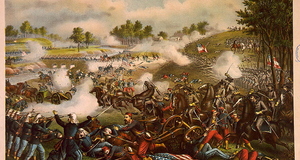From Discussions VOL. 13 NO. 1A Tale of Mattel's Two Dolls and the Politics of Dollplaying: A Critical Examination of Barbie and American Girl's Roles in Educating Young American Girls
By
Discussions 2017, Vol. 13 No. 1 | pg. 1/1
IN THIS ARTICLE
KEYWORDS
A quintessential aspect of many American girls' childhood involves plastic bodies (Rogers, 1999, 112). Pieced together by molded plastic heads, plastic arms, and plastic legs that are efficiently mass-produced by our formidable technology today, dolls are inanimate objects: silent, unable to walk on their own feet, and certainly incapable of independent thinking (medicaldaily.com). Yet, despite all these characteristics, dolls such as Mattel's Barbies and American Girls play a significant role in early childhood education and socialization (Jillson, 2011, 99). While young American girls construct identities for their dolls by conjuring stories for them, to an arguably greater extent, their identities are in turn shaped by the inanimate dolls. Indeed, the very act of playing with dolls is a form of education in itself. While Barbie and American Girl, two of Mattel's most renowned doll products, teach important lessons on values such as self-confidence and independence, the way in which dolls shape ideology is often politically and socially problematic. To understand what kinds of lessons girls may learn from doll-playing, one needs to first appreciate the complexity inherent within our protagonists, who serve as the teachers and influencers in girls' early development: Barbie and American Girl. Setting the Stage: Our Protagonists as Imperfect Icons/Role Models"Some Like It Barbie", "Barbie Like Me", "My Fair Barbie", "Our Barbies, Our Selves", and "The Woman Who Would Be Barbie" are just some chapter titles of M. G. Lord's Forever Barbie: The Unauthorized Biography of a Real Doll (Lord, 1994, 106, 158, 180, 222, 244). As these titles suggest, Barbie dolls not only provide young girls with a means of self-identification,but also serve as icons: "Indeed, the very act of playing with dolls is a form of education in itself." individuals who provide "a point of recognition widely shared with other members of one's society" and let people "imaginatively explore race, sexuality, and femininity" (Rogers, 1999, 2-3). Barbie is an icon intended to have more direct personal connection through possession with girls, allowing a sense of autonomy and ownership (Lord, 1994, 1). This unique attribute of Barbie could potentially amplify the doll's power unintentionally, by influencing little girls' early childhood development, molding certain aspects of their identity, attitudes, values, and ideology in both positive and negative ways. "For instance, Barbie restricts the definition of women's beauty by limiting it to traditional roles for women, as exemplified by her arched feet that could not flex and thus could only wear high heeled shoes." Fundamentally, Barbie is a fashion doll that encourages creativity, individuality, and the audacious pursuit of beauty. Barbie also embodies female independence to a certain extent, since there are no familial relations in Barbie's world (Piche, 2009, 7). Her creators altered Barbie's figure by giving her the image of femininity without the reality of femininity (i.e. breasts with no nipple, flared hips with no womb, and spread legs with no vagina): in short, "no milk, no sucklings, no procreation" (Cunningham, 1993, 21). However, there are tensions between the aforementioned liberating and empowering qualities that the doll encourages in girls and the simultaneously restrictive role Barbie plays to "confine women within a certain role" (Piche, 2009, 5). For instance, Barbie restricts the definition of women's beauty by limiting it to traditional roles for women, as exemplified by her arched feet that could not flex and thus could only wear high heeled shoes (Piche, 2009, 9). Barbie's intrinsic complexity extends far beyond this tension, as we may find by delving into her history and evolution. Indeed, the doll's very origin may be shocking for those unacquainted with Barbie's history. Far from being inspired by another children's doll, Barbie was born out of her creator's wish to emulate a "German sex doll designed for adults"; one that is hyper-sexualized yet still bound by traditional European standards of femininity (Lord, 1994, 8). The evolution of Barbie features a few paradoxes. In order to communicate the message that any girl can aspire to be and identify with a Barbie, the designers initially made Barbie's facial features look bland (Barbie Nation: An Unauthorized Tour Collector's Edition, 2007). Over time, however, Barbie has evolved to become incrementally more beautiful to generate more revenue for Matte(see Appendix A) by satiating America's obsession with beauty: For example, Barbie's doll packaging overuses the word beautiful, hinting at an excessive obsession with linking beauty to superficiality, materialism, and consumerism — many criticized aspects of American culture from which children should be protected (Thomas, 2000, 70). Even as touchable icons, the standard of beauty that Barbie creates is still virtually unattainable. Barbie has promoted a doll culture where its centerpiece, the "American Waistland" (see Appendix B), encourages the idea of seeing women as bodies rather than possessing bodies, and has repeatedly provoked criticisms related to eating disorders (Edut, 1998, 222; Cunningham, 1993, 81, 79). To respond to such criticisms, Mattel has introduced a new collection featuring a variety of figures such as curvy, tall, and petite (barbie. com). Meanwhile, Mattel has also responded to external pressures to diversify the racial makeup of Barbies by expanding its product portfolio to include more ethnic representations, although the original white, blonde model is still referred to as the standard (Schwarz, 2005, 299). Despite the company's timely adaptations, however, sales have been faltering. In contrast, Mattel's more recently acquired American Girl collection continues seeing increase in sales (Sherry, 2009, 202). "Indeed, we may wonder why Addy, the African American girl, lives back in the slavery era instead of the modern day." Sometimes called "the Anti-Barbie" for moving beyond tired stereotypes by looking "normal" and "real", American Girl is distinct from Barbie even though they are owned by the same company and both are critical to the early development of children (Inness, 1998, 164). As the brand name suggests, the 18-inch American Girl dolls are girls rather than teenagers, and are therefore not sexualized (americangirls.com). Since the dolls are closer in age to their users, girls may relate more closely to them. Instead of being a platform for projecting into one's teenage future and serving as an iconic figure whose beauty status is near-unachievable as in Barbie's case, where "reality is not the intention" (Schwarz, 2005, 298), American Girls set good examples in communicating positive values (e.g. philanthropy, family values, and self reliance) which can help make positive differences in society (Inness, 1998, 166). Compared to Barbie, American Girls can be considered more realistic role models for young girls to emulate. Unlike the European-inspired and internationally famous Barbie whose product portfolio includes "Barbies around the world" (barbie.com), American Girl is more "America-centric" (Inness, 1998, 175). There is great emphasis on educating girls on American history, since the brand's most popular product line features 13 fictional dolls representing nine historical eras and several ethnic groups in the United States (americangirl. com). The books that accompany the dolls create a narrative of a protagonist's life in her specific historical time period (Inness, 1998, 169). Although these stories take place in America's past that may be unfamiliar to them, contemporary American girls tend to create intricate backstories for their dolls, "intertwining content from the books with their own family histories" (Diamond, 2009; Sherry et. al., 2009, 118). This further illustrates the extent and influence of American Girl dolls on young American girls. Although American Girl exemplifies a more socially acceptable lifestyle than Barbie does and dispels parents' concerns on "precocious sexualization" (Diamond, 2009; Sherry et. al., 2009, 123), the dolls are certainly not flawless (Inness, 1998, 169). From the beginning , American Girl has been criticized for being unaffordable for the majority of American families, ranging from 115 to 120 dollars per doll, contradicting its name's hinted universality of its unique brand. Further, as much as Barbie is a flawed icon, American Girls are also imperfect role models whose influence can be problematic at times, despite their wellmarketed positive values. The brand has also been criticized for ignoring the complexity of American history, specifically the absence of unhappy endings and presenting unrealistic and tereotyped accounts of racial differences and ethnic minority characters (Sekeres, 2009, 408). "Although American Girl does not explicitly state that everything is historically accurate, for young girls the books often construct illusions that confuse the line between fiction and nonfiction." The Home: Politics of PlayGirls, sometimes unconsciously, learn intrinsically complicated identities from the plastic bodies' and as a result become more social. As plastic as their bodies are, dolls can actually be "imbued with [three main forms of] ideology": the plitics of advocacy, attack, and assent (Inness, 1998, 170). The politics of advocacy and attack are reverse sides of the same coin: while the politics of advocacy refers to "pleading for and promoting a specific cause, or upholding a particular point of view or course of action as being valid and right" (Sutherland, 1985, 145), the politics of attack is generated by "amusement, outrage, or contempt when [people] encounter something that runs counter to their concepts of right and wrong, good and evil[, etc.]" (Sutherland, 1985, 147). In American Girls(see Appendix C), both the politics of advocacy and attack are present; the former is exemplified by the "revisionary history that offers girls new stature". Not only are the American Girl dolls and novels presenting girls' history, but also actively promoting it, which is a worthwhile change from the typical omission of females from history. This is illustrated by the recurrent attack on the evils of slavery in the novel Meet Addy: An American Girl (Inness, 1998, 172-174). Both politics of advocacy and attack teach "behavioral messages that have broad appeal" to girls, underscoring the significance of dolls in influencing young American females in their early stages of growth (Inness, 1998, 174). If the three forms of ideology were mapped on a spectrum, placed in between the politics of advocacy and attack would be the comparatively insidious and often hidden politics of assent, defined as affirming the status quo and continually reinforcing it (Sutherland, 1985, 151, 155). Examples are omnipresent in both Mattel dolls. For American Girls, not only is it present in the collection's "overwhelmingly Americancentric attitude" revealed in the brand name itself but also in the books' repeated suggestion of American superiority as a vision that becomes so familiar that people assume it is the truth. The politics of assent also works to show only long hair as natural on women and implies that short hair is unfeminine on both Barbies and American Girls, serving as a traditional standard on how girls are expected to look and reinforcing established societal norms of feminine culture (Inness, 1998, 175, 177). The politics of assent is further exemplified by American Girl's presentation of its collection as real history (Inness, 1998, 175-176). Although American Girl does not explicitly state that everything is historically accurate, for young girls the books often construct illusions that confuse the line between fiction and nonfiction. This may have disturbing effects, especially since the stories are largely legitimized by their presence in schools. Here the politics of assent renders American Girl's approach to teaching American history to girls partially problematic, for the dolls and their accompanied backstories already constructed by Mattel help form young American girls' limit notions about the history of race and ethnicity (Inness, 1998, 176). Noticeably, most novels sold with the dolls focus on upper class characters and present the United States as largely white with little to no mention of other ethnic groups in a positive manner. The politics of assent can be further linked to what Schwarz, 2005, terms as "the politics of nostalgia" in both dolls' cases (297). Native American Barbies, like many other ethnic minority dolls from both the Barbie and American Girl collections, demonstrate Mattel's tendency to present "frozen stereotypes", where Native American Barbies still live in a pristine past and are always dressed for special, traditional occasions(Schwarz, 2005, 295). In these instances, the politics of nostalgia often works to "conceal fundamental ideological principles used to legitimate a dominant one-dimensional view of history written as an unchanging narrative" (Schwarz, 2005, 298). This "commodification of folklores", while helpful in generating more profit for Mattel, engenders a false illusion that distorts the ethnic group's view of their identity in the past and present, while reinforcing damaging stereotypes(Thomas, 2000, 65). Meanwhile, we may use similar logic to critically examine the American Girl collection's strategy of focusing on earlier periods in American history as a means of socializing contemporary American girls with strategically preselected emphases and purposeful understatements of today's persisting racial violence. Indeed, we may wonder why Addy, the African American girl, lives back in the slavery era instead of the modern day. While one may argue that focusing on injustice in America's past shields young children from harsh social and political realities and intelligently helps Mattel maintain racial correctness, this approach can have drawbacks (Wall, 2010, 799). One limitation concerns individual American identity. Consider, for instance, a black girl whose family immigrated to the United States from Africa 20 years ago. While the girl may be a U.S. citizen, she may not identify with Addy because her family history is one that is devoid of slavery. This could curtail her own American identity, and reduce the doll's influence. These concerns highlight the multifaceted complexity of dolls' roles in educating young American girls. One could further evaluate the politics of doll-playing by broadening the scope of consideration more holistically to include the market at large, both from the demand side (American girls as dollplayers and consumers) and supply side (Mattel, the creator of Barbies and American Girls). The Market: Consuming Children and the Cycle of "Parenting"In our capitalist system, consumers have the right and freedom to choose which products they would like to purchase; suppliers produce goods to generate revenue. The relationship between commodities, producers, and consumers is complicated, as the doll-player's internal personal territories and external corporate/ cultural politics shape each other (Chin, 1999, 306). While children's demand for dolls can create and influence supply, sometimes boosting Mattel's sales as a result, the outward forces of corporate and cultural politics also invade children's personal territories by educating them in potentially problematic ways. One should further consider the nature of children who are consumed by the enchanting allures of doll-playing, as one examines both the supply and demand in relation to the mutual influence between the marketplace and the mind (Diamond, 2009; Sherry et. al., 2009, 126). Existing scholarship on children as consumers is generally polarized between those who feel that children's innocence must be protected from corporate advertising, and scholars who feel that children have the rights as consumers (Linn, 2004, 1; Sekeres, 2009, 405). Often, the decision-making power to choose between protecting children from corporate influence and granting them more liberty to make decisions as independent consumers belongs to the parents (Diamond, 2009; Sherry et. al., 2009, 122). "However diverse the dolls and their stories may be, they share similar, often problematic ideologies reaffirm stereotypes and upholding dominant societal values and culture." Although girls are the direct consumers of Barbies and American Girls, their parents make the purchase. This purchase has broader implications: it transfers an aspect of parenthood to Mattel: the lucrative corporation to which educating children is a means to profit maximization. Mattel's American Girl Place, the supply side, can be understood as an "archetypal parent": not only a shrine worshipped by girl consumers, but also a dwelling: it is both a commercial and domestic space (Diamond, 2009; Sherry et. al., 2009, 132). On the demand side, girls may also take a parental role when they create and shape identities for their Barbies and American Girls in role-play games (Schwarz, 2005, 296). Ironically, it is the Barbies and American Girls that serve as an imaginative outlet who remain as powerful educators and influencers molding the girl consumers' identities and ideologies while the girls pretend to be shaping theirs through imagined parental dominance (Piche, 2009, 5). At the marketplace, girls who are ostensibly only picking their playmates are actually choosing the way in which they want to be molded. However diverse the dolls and their stories may be, they share similar, often problematic ideologies reaffirming stereotypes and upholding dominant societal values and culture. In the cycle of parenting, biological parents delegate some of their parental power of raising their daughters to Mattel, whose agents, Barbie and American Girl dolls, socialize and educate the children in spite of their own static state. Young American girls, meanwhile, fantasize by imagining themselves as parents educating their daughters, the dolls, who in turn shape and mold their own identities. Conclusion: Plasticity in ReverseDoll-playing, a seemingly simple childhood pastime that is most commonly associated with the domestic setting, is intricately intertwined with the outside world. Not only do Barbies and American Girls arrive at girls' homes from their corporate creator Mattel, but they also influence girls on their identity (Rogers, 1999, 1). Indeed, the dolls are not so plastic, after all. While girls receive history lessons and absorb American societal and moral values such as charity and independence through doll-play, Barbie and American Girl's roles in socializing American girls are problematic in elements such as their frozen racial representations and constraints on femininity per traditional standards. The reinforcement of society's status quo, inherently present in both types of Mattel's malleable plastic bodies, may dangerously shape girls in static directions skewed towards dominant groups. Static, much like the dolls' unalterable and somewhat uncanny smiles made from inanimate plastic. AuthorXiaoyi is a junior majoring in politics and minoring in Spanish at Pomona College, one of America's top undergraduate institutions. She has contributed regularly to the Huffington Post, USA TODAY, South China Morning Post (Hong Kong), Caixin Media (mainland China), and China Files (articles in Spanish). AcknowledgementsMy deep gratitude goes to my parents, who have been extremely encouraging. They have taken the initiative in arranging some of the logistics, and have provided much guidance, love, and support in innumerable ways throughout my journey in life. I would also like to thank my professors and friends at Pomona College for an intellectually fulfilling academic experience thus far. Finally, I thank you, my readers. ReferencesAmerican Girl. Dolls, clothes, games & gifts for girls. (2016, May 08). Retrieved from americangirls.com. Barbie. Fashion Dolls and Toys for Everyone. (2016). Retrieved from barbie.com. Chin, E. (1999). Ethnically Correct Dolls: Toying with the Race Industry. American Anthropologist 101(2), 305-321. doi:10.1525/AA.1999.101.2.305. Diamond, N., Sherry, J., Muniz Jr., A. M., Mcgrath, M. A., Kozinets, R. V., Borghini, S. (2009). American Girl and the Brand Gestalt: Closing the Loop on Sociocultural Branding Research. Journal of Marketing 73(3), 118–134. doi:10.1509/jmkg.73.3.118. Edut, O. (1998). Adiós, Barbie: Young Women Write about Body Image and Identity. Seattle, WA: Seal. Hernandez, J. (2009). "Miss, You Look Like a Bratz Doll": On Chonga Girls and Sexual-Aesthetic Excess. NWSA Journal 21(3), 63-90. doi:10.1353/nwsa.0.0102 Honigsberg, Peter Jan (1995). "A Barbie Doll Story". The Phi Delta Kappan 77(3), 252-256. Inness, S. A. (1998). Delinquents and debutantes: Twentieth-century American girls' cultures. New York: New York University Press. 164-183. Jillson, C. C. (2011). American government: Political development and institutional change. New York: Routledge. Linn, S. (2005). Consuming kids: The hostile takeover of childhood. New York: New Press. Lord, M. G. (1995). Forever Barbie: The unauthorized biography of a real doll. New York: Avon Books. Olson, S. (2014, December 31). Why Are Barbie's Body Measurements So Unrealistic? Little Girls Aren't Buying It. Medical Daily. Retrieved from http://www.medicaldaily.com/pulse/barbies-body-measurements-set-unrealisticgoals-little-girls-sales-plummet-316006 Piche, B. (2009). "The Intentions Behind the Creation of Barbie". Constructing the Past 10(1), 6-13. Available at: http://digitalcommons.iwu.edu/constructing/vol10/iss1/4 Rogers, M. F. (1999). Barbie culture. London: SAGE Publications. Sekeres, D. C. (2009). The Market Child and Branded Fiction: A Synergism of Children's Literature, Consumer Culture, and New Literacies. Reading Research Quarterly, 44: 399-414. doi: 10.1598/RRQ.44.4.6. Schwarz, M.T. (2005). Native American Barbie: The Marketing of Euro-american Desires. American Studies, 46(3/4), 295-326. Sherry, J. F. (2009). The Work of Play at American Girl Place. Social Psychology Quarterly 72(3), 199-202. doi:10.1177/019027250907200301. Simms, E-M. (1996). Uncanny Dolls: Images of Death in Rilke and Freud. New Literary History 27(4), 663-677. Stern, S. (2007). Barbie Nation: An Unauthorized Tour Collector's Edition. USA. Allegro. Sutherland, R. D. (1985). Hidden Persuaders: Political Ideologies in Literature for Children. Children's Literature in Education 16(3), 143-57. Thomas, J. B. (2000). "Ride 'em, Barbie Girl: Commodifying Folklore, Place, and the Exotic". Polly Stewart et al. Worldviews and the American West: The Life of the Place Itself (65-86). University Press of Colorado. Wall, C. A. (2010). On Dolls, Presidents, and Little Black Girls. Signs 35(4), 796-801. doi:10.1086/651034. AppendixSuggested Reading from Inquiries Journal
Inquiries Journal provides undergraduate and graduate students around the world a platform for the wide dissemination of academic work over a range of core disciplines. Representing the work of students from hundreds of institutions around the globe, Inquiries Journal's large database of academic articles is completely free. Learn more | Blog | Submit Latest in Women's & Gender Studies |



















